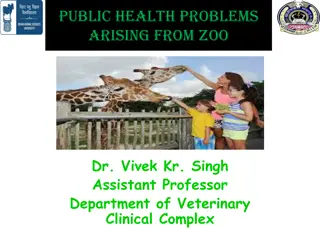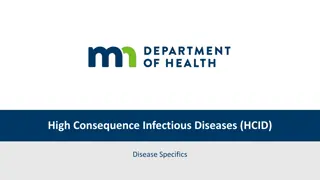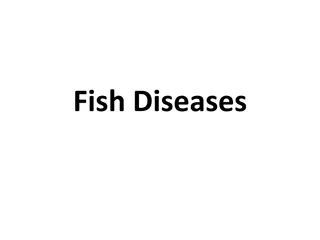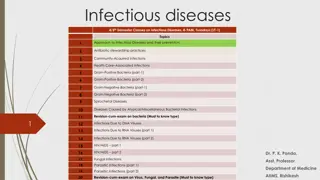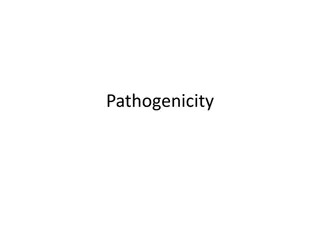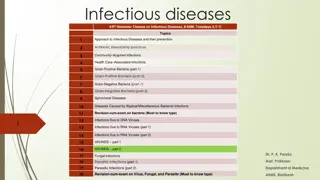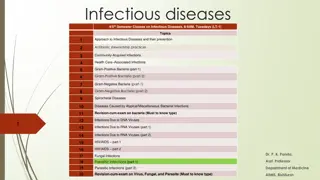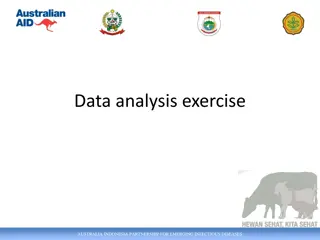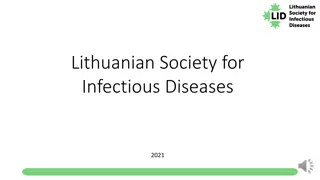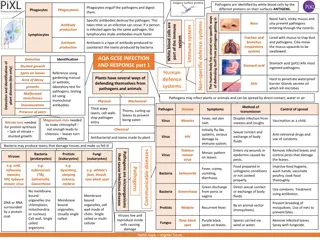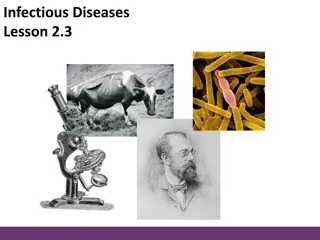Understanding Emerging and Re-emerging Infectious Diseases
Emerging and re-emerging infectious diseases pose significant challenges to global public health, with factors such as increased human-animal contact and microbial resistance contributing to their spread. This presentation explores the definitions, examples, and impacts of these diseases, emphasizing the need for heightened awareness and proactive measures to mitigate their effects.
Download Presentation

Please find below an Image/Link to download the presentation.
The content on the website is provided AS IS for your information and personal use only. It may not be sold, licensed, or shared on other websites without obtaining consent from the author. Download presentation by click this link. If you encounter any issues during the download, it is possible that the publisher has removed the file from their server.
E N D
Presentation Transcript
Introduction to emerging and re-emerging infectious diseases DOREEN SITALI SCHOOL OF PUBLIC HEALTH DEPT. OF HEALTH PROMOTION AND EDUCATION
Introduction Global eradication of smallpox in 1977 and discovery of antibiotics led to optimism and complacency that infectious diseases as public health problems could be eradicated or eliminated Complacency led to fatal consequences; infectious diseases are leading cause of death globally today. About 17 million people die from infectious diseases annually
Session objectives Define key terms Identify common drivers of emerging and remerging infectious diseases Discuss the impact of EIs Identify measures to mitigate EIs
What are emerging and re-emerging infectious diseases? EIs - newly identified /unknown infections which cause public health problems locally or globally Term includes infections spreading to new geographic areas and those diseases that were responding to antibiotics but are now resistant
Not always possible to know if these diseases are new in humans, or whether were present but unrecognized throughout the years EIs thought to be due to a closer contact of man with their reservoirs in nature, with a successful jump of the infectious agent from animal to man across the species barrier
Examples of EIs HIV infection which causes AIDS, with its sequelae of human suffering and economic burden Ebola hemorrhagic fever with a potential for international spread Other examples of new or newly detected infectious diseases of global concern include a new form of cholera hepatitis C and hepatitis E Legionnaires disease, and Lyme disease, dengue fever, West Nile virus, and the Zika virus. COVID
Re-emerging infectious diseases infections that have appeared after significant decline in their incidence often reappear in epidemic proportions. Tuberculosis increasing worldwide due in part to its close association with HIV infection cholera re-introduced into countries and continents where it had previously disappeared, and where it can spread because water and sanitation systems have deteriorated dengue or breakbone fever has started to occur in urban areas where mosquito control has broken down.
Reemerging diseases include Malaria, Tuberculosis, Cholera, Pertussis, Influenza, Pneumococcal disease, and gonorrhea. Ebola , Marburg Crimean congo haemorrhagic fever Lassa fever MERS, SARS Nipah, Rift valley fever Covid
Why are these diseases emerging? Emergence is multifactorial in origin: Rapid population growth uncontrolled urbanization- crowded cities- unhygienic conditions that provide breeding ground for pathogens intense international travel and growing trade and tourism Migration and displacement of people due to war, strife or disasters Agricultural practices
changes in handling and processing of large quantities of food; and increased exposure of humans to disease vectors and reservoirs in nature. Mutations that lead to new strains; and drug resistance; Resistance of vectors to pesticides Most significant factor: deteriorating public health infrastructure which is unable to cope with population demands, and the emergence of resistance to antibiotics linked to their increased misuse.
Bioterrorism Possible deliberate release of infectious agents by dissident individuals or terrorist groups Biological agents are attractive instruments of terror easy to produce, mass casualties, difficult to detect, B. anthracis, C. botulinum toxin, F. tularensis, Y. pestis, Variola virus, Viral haemorrhagic fever viruses Likeliest route aerosol dissemination
During first half of the 20th century deaths from infectious diseases declined because of improved hygiene and nutrition. This trend was strengthened with the advent of vaccines and antibiotics during the 1940s and culminated in the late 1970s in the eradication of one infectious disease, smallpox. Because at that time infectious diseases appeared to be a decreasing threat, funds for their control were channeled to other problems, experts on infectious disease retired or left the field and students turned to more rewarding subjects than viruses and bacteria - the infrastructure for communicable disease control began to crumble.
Emerging and re-emerging infections reflect the constant struggle of microorganisms to survive.
Transmission of Infectious Agent from Animals to Humans ZOONOTIC diseases >2/3rd emerging infections originate from animals wild & domestic e.g Emerging Influenza infections in Humans associated with Geese, Chickens & Pigs Animal displacement in search of food after deforestation/ climate change (Lassa fever) Humans themselves penetrate/ modify unpopulated regions come closer to animal reservoirs/ vectors (Yellow fever, Malaria)
Impact of EIs Economic Social Public health
PRIORITY AREAS FOR ACTION 1. STRENGHTHENING NATIONAL CAPACITIES Create early warning systems and rapid response mechanisms Strengthen epidemiological laboratory and systems Early action for prevention and control
2. Intersectoral collaboration Constant dialogue about the health implications of projects in other ministries Close collaboration between health and other ministries
Intercountry collaboration Rapid flow of disease surveillance between countries
The global response Since 1992 alarm over emerging and re-emerging diseases resulted in a number of national and international initiatives to restore and improve surveillance and control of communicable diseases. Member States of WHO expressed their concern in a resolution of the World Health Assembly in 1995, urging all Member States to strengthen surveillance for infectious diseases in order to promptly detect re-emerging diseases and identify new infectious diseases. The WHA recognized that the success of this resolution depends on ability to obtain information on infectious diseases and willingness to communicate information nationally and internationally.
The World Health Organization warned in its 2007 report that infectious diseases are emerging at a rate that has not been seen before. Since the 1970s, about 40 infectious diseases have been discovered, including SARS, Ebola, Avian flu, and Swine flu
Surveillance and Response Global Outbreak Alert & Response Network Coordinated by WHO Mechanism for combating international disease outbreaks Ensure rapid deployment of technical assistance, contribute to long term epidemic preparedness & capacity building Applied Research Infrastructure and Training Prevention and Control
Conclusion Infectious diseases will continue to dominated disease scenarios in most countries. The most sustainable way to deal with them is through early detection and rapid response.







